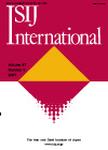版权所有:内蒙古大学图书馆 技术提供:维普资讯• 智图
内蒙古自治区呼和浩特市赛罕区大学西街235号 邮编: 010021

作者机构:Wuhan Univ Sci & Technol Sch Machinery & Automat Minist Educ Key Lab Met Equipment & Control Technol Wuhan 430081 Peoples R China Huazhong Univ Sci & Technol Minist Educ Key Lab Image Proc & Intelligent Control Wuhan 430074 Peoples R China
出 版 物:《ISIJ INTERNATIONAL》 (日本钢铁学会杂志国际版)
年 卷 期:2021年第61卷第11期
页 面:2773-2784页
核心收录:
学科分类:080602[工学-钢铁冶金] 0806[工学-冶金工程] 08[工学]
基 金:National Natural Science Foundation of China open fund of Key Laboratory of Image Processing and Intelligent Control (Huazhong University of Science and Technology), Ministry of Education [IPIC201903] Hubei Key Laboratory of Mechanical Transmission and Manufacturing Engineering at Wuhan University of Science and Technology [2018A04]
主 题:class-specific and shared dictionary discriminative dictionary learning image classification surface defects of steel sheet
摘 要:For surface defect images that captured from a practical steel production line, feature extraction for classification is a challenging task due to inter-class similarity and intra-class difference of defect images. In this paper, we propose a class-specific and shared discriminative dictionary learning (CASDDL) method for extracting discriminative class-specific features to classify surface defects of steel sheet. Specifically, we learn a shared sub-dictionary as well as several class-specific sub-dictionaries to explicitly capture common information shared by all classes and class-specific information belonging to corresponding class. We adopt a mutual incoherence constrain for each sub-dictionary to encourage learned sub-dictionaries to be as independent as possible. A Fisher-like discriminative criterion is also introduced to coding vectors over all the class-specific sub-dictionaries, which can indirectly improve the discriminative ability of learned dictionary. In addition, we further impose a low-rank constrain on coding vector over shared sub-dictionary to guarantee learned dictionary has the abilities of same class of samples itself reconstruction and different class of samples reconstruction. Finally, classification can be efficiently performed by discriminative coding vector that obtained from a reconstructive and discriminative dictionary. Experimental results demonstrate that our proposed CASDDL method achieves a comparable or better performance than the state-of-the-art dictionary learning methods in classifying surface defects of steel sheet.